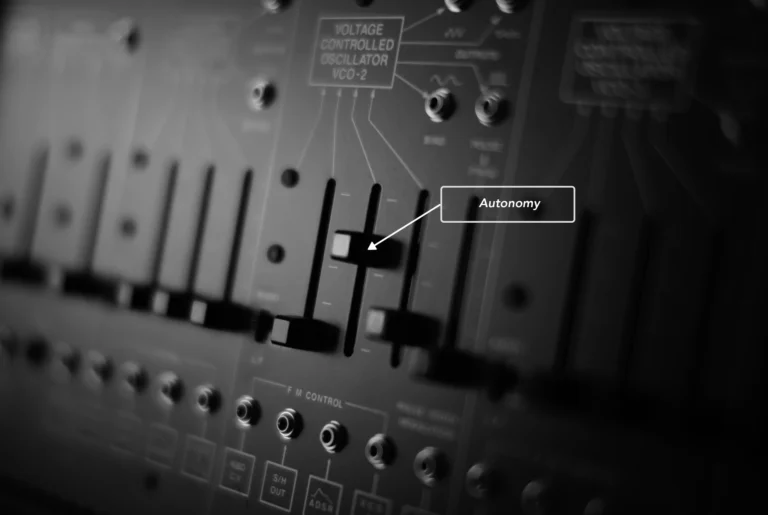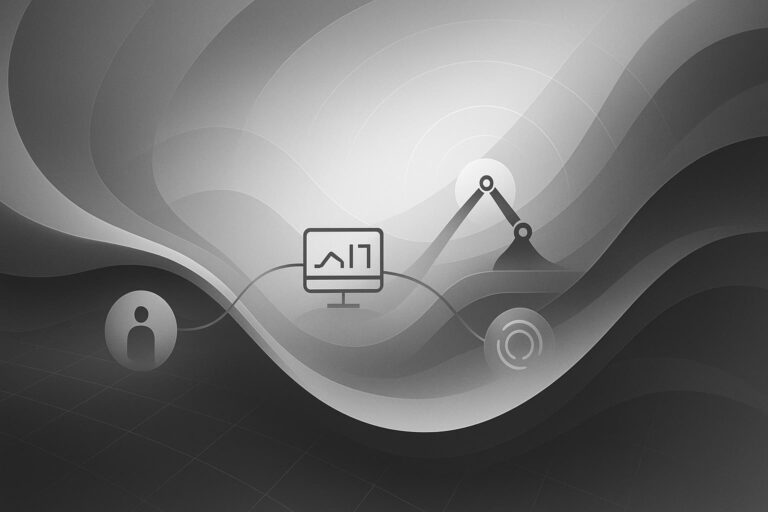The Transformative Future of AI in Robotics
The robotics industry is entering a new era defined by generative AI. OpenAI, Anthropic, etc. are no longer just providing supporting tools we use; they are becoming a driver of robotic capabilities and operations. From controlling humanoids to insightful analytics, generative AI enables robots to learn from data and apply in real time.
To fully harness this potential, robotics operations platforms must evolve beyond traditional human-centered interfaces. They need to accommodate generative AI systems as first-class users. In practical terms, this means enabling machine-readable data sources and generative AI decision-making alongside human oversight. At Formant, our strategy recognizes this reality. We embrace an objective, reality-driven view of technology: if generative AI can make robotics operations more efficient and capable, our platform must be designed to leverage it.
Evolving Our Product Strategy for the Generative AI Era
In light of these trends, Formant is investing in product development to let our customers take advantage of the myriad of AI developments happening. Historically, managing robot fleets often meant using human-oriented dashboards or “mission control” interfaces, and extending them with human oriented APIs (documentation, OpenAPI service descriptions, client code libraries). These will remain, but we recognize that we need to add generative AI tooling to provide for the next generation of interfaces and visualizations.
We see clearly that a paradigm shift is needed. We are moving from a world with the human-to-machine approach being the norm toward one with machine-to-machine as the primary with humans being guides. This shift will require us to make our platform just as accessible to algorithms, scripts, and AI agents as it is to human users. By rethinking our product with this vision in mind, we empower customers (especially non-technical customers) to integrate and automate robotics operations in ways that would not have been possible before.
Machine-Readable APIs: Empowering Customers and Future-Proofing Capabilities
The cornerstone of our new work is offering comprehensive machine-readable APIs across the Formant platform. Simply put, every function or piece of data available through our user interface will be made accessible through secure APIs, semantically described for AI agents. Why is this so transformative? Because APIs enable software – whether it’s a customer’s custom application or an AI-driven tool – to directly communicate with our platform. This empowers our customers in several key ways:
- Agentic User Experiences: While our clients can build tailor-made solutions on the Formant platform, we anticipate the industry trend towards leveraging agentic client applications (e.g., ChatGPT, Claude) for just-in-time user experience generation. This empowers each business user to create optimal, personalized data visualizations tailored to their unique needs, moving beyond the limitations of handcrafted user interface or reliance on custom development. Imagine a future where AI is building Formant robotics views for you, making your single pane of glass faster to construct for the continual new questions that arise.
- Automation & Scalability: Machine-readable APIs allow robotics operations to be automated end-to-end. Routine tasks – like scheduling data uploads, initiating robot tasks, or analyzing performance metrics – can happen automatically in the background. For example, a script or AI agent can fetch telemetry data every hour and flag anomalies without any human intervention. This level of automation not only reduces manual effort; it also scales effortlessly as fleets grow.
- Future-Proof Integration: An open API ensures that as technology evolves, our customers are never locked out of new capabilities. New software tools, machine learning models, or external services can hook into Formant’s generative APIs just as easily as our own modules. This means our platform will work seamlessly with next-generation tools or AI systems that might not even exist yet. In an industry moving as fast as robotics, this kind of future-proofing is invaluable.
By exposing a rich set of APIs, Formant effectively becomes a platform that developers and domain experts can innovate on. We continue to provide a polished user interface for those who utilize it, we continue to let our customers use iframes to extend and integrate high value visualizations, but now our customers can also choose to interact with Formant purely through agents if they prefer. In short, we’re preparing our company for a world where people have mass AI fluency. It’s a confident, forward-looking step that trusts our users to drive innovation using our tools in ways we may not even anticipate.
Embracing Model Context Protocol and Agent to Agent Communication
Moving to an API-first model also means adopting modern machine-centric communication protocols. In practice, this approach lets our platform speak the common “language” of other software and robots. We use protocols that are easily understood by AI systems. While we continue to support RESTful and real-time messaging, we embrace new ones.
The Model Context Protocol (MCP) and Agent-to-Agent (A2A) protocol represent significant steps forward in enabling seamless collaboration between robot fleets and AI systems. MCP can be understood as a standardized method for robot fleets to exchange comprehensive details regarding their current state, surroundings, and ongoing activities, much like information sharing in a human meeting. Conversely, the A2A protocol facilitates direct communication between AI agents, allowing them to coordinate intricate tasks and resolve challenges collectively, analogous to teams working together on a project. These technologies are crucial in enabling generative AI systems to comprehend and manage robots with greater sophistication, thereby paving the way for more intelligent and autonomous robotic operations.
Embracing MCP and A2A communication signifies a shift from manual mission control to automated mission control. In the past, a human operator might issue commands or gather data from disparate systems. Now, humans can orchestrate generative AI to coordinate those activities by talking directly to Formant. For instance, an AI oversight system could monitor a fleet of delivery robots through our data streams. If it detects that a robot’s battery is critically low, it could automatically dispatch that robot to a charging station by calling a Formant API — all in real time, without waiting for human intervention. This kind of agent-to-agent interaction is the future of efficient fleet management.
Supporting AI-Driven Development Tools
Another pillar of our vision is support for the new wave of AI-driven development tools. Software development itself is being transformed by AI – from intelligent code assistants to systems that autonomously generate and test code. We want Formant to seamlessly integrate with these tools to accelerate robotic operations innovation.
Concretely, this means our APIs and data formats are designed to be friendly for AI consumption. For example, a machine learning engineer could use a Python script or an AI coding assistant to query Formant for robot logs, train a model on that data, and then use the API to deploy new instructions or updates to the fleet. We’re making sure such workflows are not just possible, but easy to assemble. Our documentation, software development kits (SDKs), and libraries are being refined so that even an AI agent (say, a script developed with a large language model) can understand how to interact with Formant.
Notably, we’re already seeing customers and internal teams build intelligent tools around our platform. These early adopters inspire us and validate our approach. By embracing these trends, we position our customers to take advantage of generative AI at every step – design, development, deployment, and operations. In short, we view AI not just as something that happens inside a robot, but as an integral part of the ecosystem around the robot. Our job is to make sure that the ecosystem is as integrated and powerful as possible for our customers and who they serve.
Managing Complexity While Offering Freedom
As we open up our platform through APIs and automation, one thing remains constant: Formant’s commitment to handling the backend complexity of robotics operations. We have always aimed to provide the benefits of a robust in-house infrastructure without our customers needing to reinvent it themselves. That principle isn’t changing – in fact, it’s stronger than ever.
When you build on Formant’s machine-readable APIs, you’re building on a solid foundation that we manage for you:
- Data Infrastructure: We take care of securely ingesting, storing, and processing the deluge of data from your robots – from telemetry and sensor readings to video streams. You don’t have to worry about scaling databases or maintaining servers; we handle that behind the scenes, and you access the data whenever and however you need it.
- Reliability & Scalability: Our platform is cloud-native and built to scale as your fleet grows. High availability, low latency, and the capacity to handle thousands of concurrent robot connections are challenges we solve for you. When you integrate via our API, you automatically leverage this rock-solid reliability as your operations expand.
- Updates & Maintenance: Formant continuously improves its backend with new features, performance enhancements, and fixes. By using our platform (directly or via API), you benefit from these updates automatically, without dedicating resources to maintenance. We sweat the details of uptime, updates, and scaling, so you can focus on what matters: building and deploying your robotic solutions.
The freedom we offer is the freedom to create on top of this foundation. You can think of Formant as the innovation platform for your robotics operations – we handle the low-level heavy lifting, and you have the flexibility to use your domain expertise to build the applications and workflows that suit your mission. This combination of reliability and flexibility is at the heart of our approach; it’s a rational division of labor. We do what we do best on the backend, and you’re free to do what you do best in hardware and on the frontend when valuable, without unnecessary constraints.
A Vision of Collaboration and Innovation
Formant’s evolution toward an generative AI-driven, API-first platform is guided by a clear vision: a future where humans and intelligent machines collaborate seamlessly to achieve more than ever before. This future is not a distant fantasy; it’s an achievable reality that we are actively engineering. We pursue this vision with an approach grounded in principles and pragmatism, and with a deep optimism that empowering our customers will lead to breakthroughs across the robotics industry.
This journey is one we embark on together with our community of enterprises, developers, and partners. Your feedback and creativity are crucial in refining our platform. We are excited to see the ingenious applications, integrations, and AI-driven solutions that you will build using Formant’s capabilities. By embracing openness and collaboration, we invite you to help shape the future of robotics with us.
Security, Privacy, and Ethics
No great vision of technology can go without commentary on these fundamental values. In our next part we’ll go deeper on our point of view of how these tie in with generative AI in the physical world.
— Jeff Linnell, Founder and CEO at Formant
— Richard Anaya, Head of Artificial Intelligence at Formant



